Brazos Island, a barrier island located at the southernmost tip of Texas, USA, is a popular destination among bird enthusiasts.
Known as one of the top bird-watching spots in the country, the island is home to various bird species, including migratory and resident birds.
From shorebirds to raptors, songbirds to waterfowl, birders can observe various feathered creatures on the island throughout the year.
The island’s geographical location, habitat diversity, and climate make it ideal for birdlife to thrive.
This article will explore the different bird species found on Brazos Island, their behaviour, and their importance to the ecosystem.
24 Common Birds Of Brazos Island
Brazos Island is a barrier island located in the Gulf of Mexico, off the southern coast of Texas. It is known for its diverse birdlife, especially during migration seasons. Here are 24 common birds that can be spotted on Brazos Island:
1. Bald Eagle
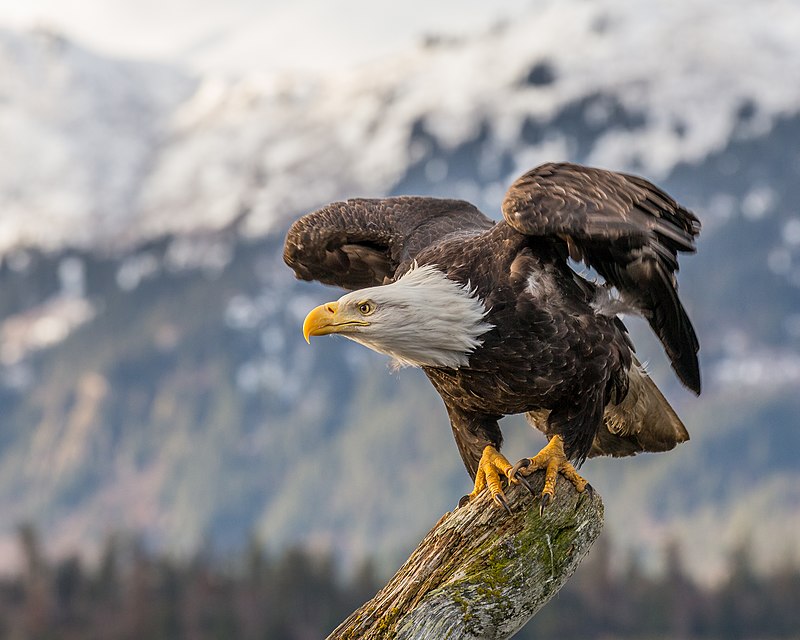
The majestic Bald Eagle is a bird of prey found in North America and recognized as the national symbol of the United States.
With its distinctive white head, brown body and striking yellow beak, this sea eagle has two known subspecies that form a species pair with the White-tailed Eagle.
It inhabits much of Canada, Alaska, all states in the US, contiguous area and Northern Mexico near large bodies of water where they feed mainly on fish.
These birds have an impressive wingspan ranging from 1.8 to 2 meters depending on their size, making them one of nature’s most magnificent creatures.
Scientific classification:
| Kingdom | Animalia |
| Phylum | Chordata |
| Class | Aves |
| Order | Accipitriformes |
| Family | Accipitridae |
| Genus | Haliaeetus |
| Species | H. leucocephalus |
Also Featured In: Most Common United States Birds, Birds Live in Arkansas
2. Neotropic Cormorant
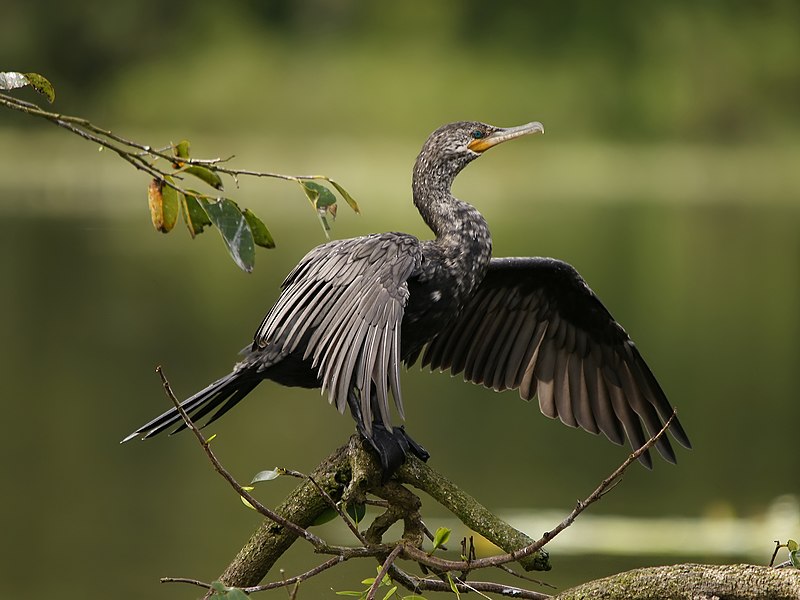
The Neotropic Cormorant, also known as the Olivaceous Cormorant, is a medium-sized bird found in tropical and subtropical regions of Central America, South America and the United States.
It can be identified by its black body with bright yellow facial skin on both sides of its large bill. The tail feathers are short and squared off at the tip.
This species breeds mainly on coasts but will sometimes nest inland near rivers or lakes during certain parts of their life cycle.
They feed mostly on small fish caught while diving underwater but can also eat crustaceans, amphibians and insects.
These birds roost in trees at night to keep them safe from predators like foxes, which prey upon them when they sleep close to water sources during daylight hours.
Scientific classification:
| Kingdom | Animalia |
| Phylum | Chordata |
| Class | Aves |
| Order | Suliformes |
| Family | Phalacrocoracidae |
| Genus | Nannopterum |
| Species | N. brasilianum |
Also Featured In: Beautiful Brazilian Birds, Rainforest Birds You Should Know
3. Pied-Billed Grebe
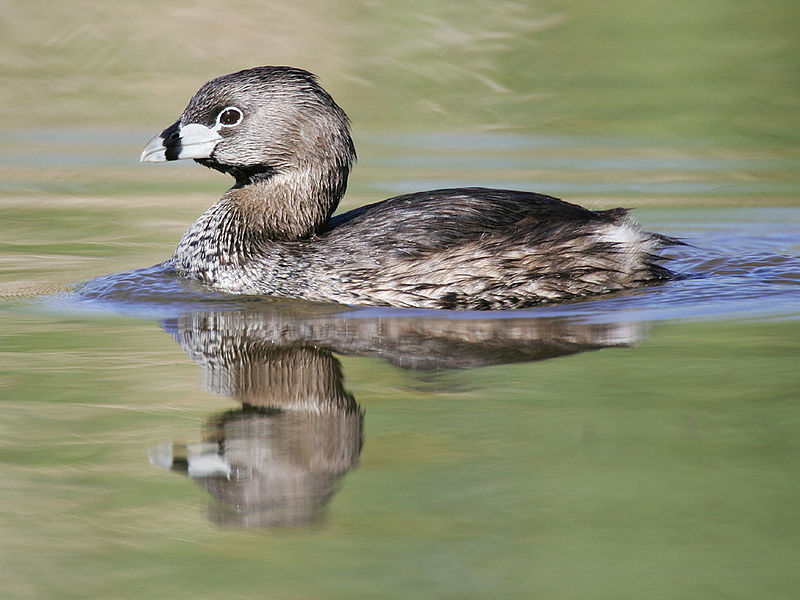
The Pied-billed Grebe is a water bird found in ponds throughout the Americas. It has earned many nicknames, including American dabchick, rail, and Carolina grebe.
This grebe species can be recognized by its distinctive bill, which is pied or mottled with black and white markings.
Its brownish body is also covered in dark spots, and it has long legs for swimming underwater to catch food, such as aquatic insects and crustaceans.
The Pied-billed Grebes are monogamous birds that pair up during the breeding season from spring to summer, where they build their nests together on vegetation near the shoreline of lakes or slow-moving rivers.
These birds are solitary outside of mating season but will form small flocks when migrating south for winter months.
Scientific classification:
| Kingdom | Animalia |
| Phylum | Chordata |
| Class | Aves |
| Order | Podicipediformes |
| Family | Podicipedidae |
| Genus | Podilymbus |
| Species | P. podiceps |
Also Featured In: Top Birds Found in Mexico, Common Central Park Birds
4. Green Heron
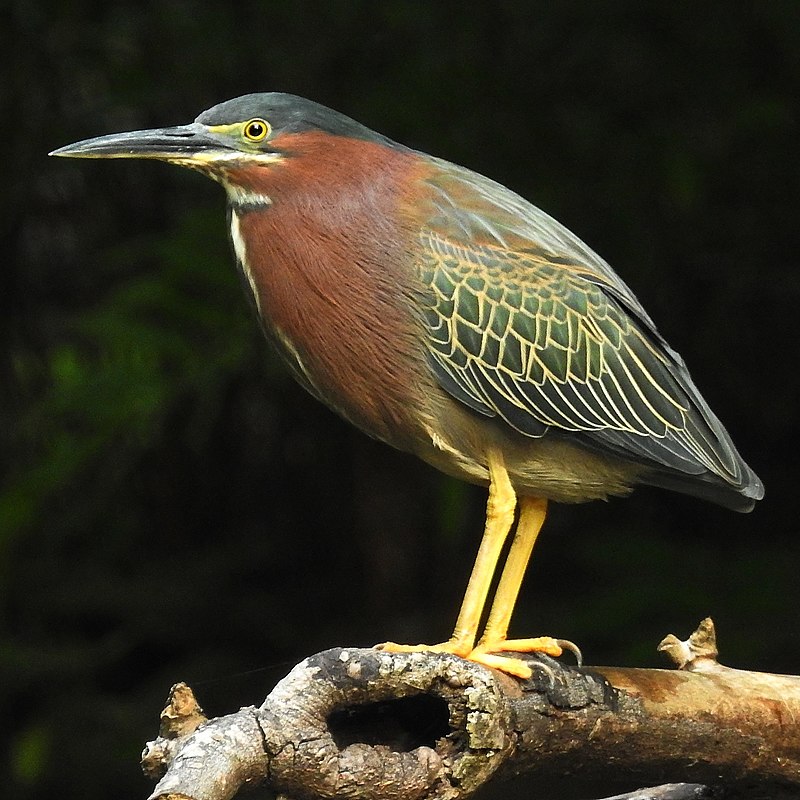
The Green Heron (Butorides virescens) is a small heron found throughout North and Central America.
Its scientific name comes from the Middle English ‘butor’, meaning bittern, and the Latin term for its distinctive greenish colour – ‘virescens’.
For many years, it was considered to be part of the same species as the Striated Heron (Butorides striata), commonly referred to as “green-backed herons”.
The nominate subspecies inhabits wetlands across much of this range, where they can be spotted stalking about in shallow water, looking for fish or frogs on which to feed.
They are fascinating wading birds that have even been known to use tools such as sticks or baited lines when fishing.
Scientific classification:
| Kingdom | Animalia |
| Phylum | Chordata |
| Class | Aves |
| Order | Pelecaniformes |
| Family | Ardeidae |
| Genus | Butorides |
| Species | B. virescens |
Also Featured In: Common Southern Californian Birds, Birds that You’ll Find in Puerto Rico
5. American White Ibis
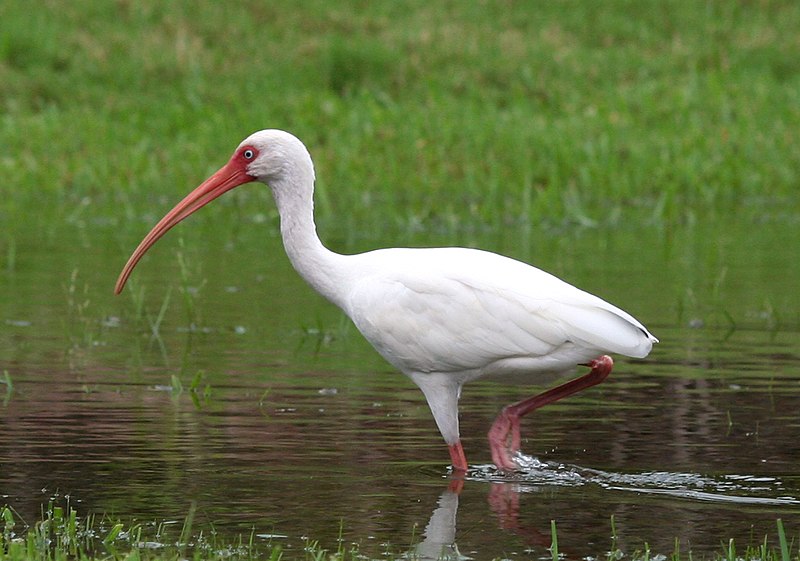
The American white ibis is a medium-sized bird with an overall white plumage and long legs. It has a bright red-orange downward curved bill and black wing tips, usually only visible in flight.
This species of ibis can be found from Virginia south through most of the coastal New World tropics.
They have been known to inhabit marshes, swamps, ponds, lakeshores, and mangrove forests near water sources where they feed on crustaceans such as crabs and shrimp, among other aquatic animals like insects or snails.
The American white ibis plays an important role in its ecosystem by helping to control insect populations, which helps maintain balance within these environments.
Scientific classification:
| Kingdom | Animalia |
| Phylum | Chordata |
| Class | Aves |
| Order | Pelecaniformes |
| Family | Threskiornithidae |
| Genus | Eudocimus |
| Species | E. albus |
Also Featured In: Birds You’ll Find in South Texas , Swamps Birds You Should Know
6. Reddish Egret
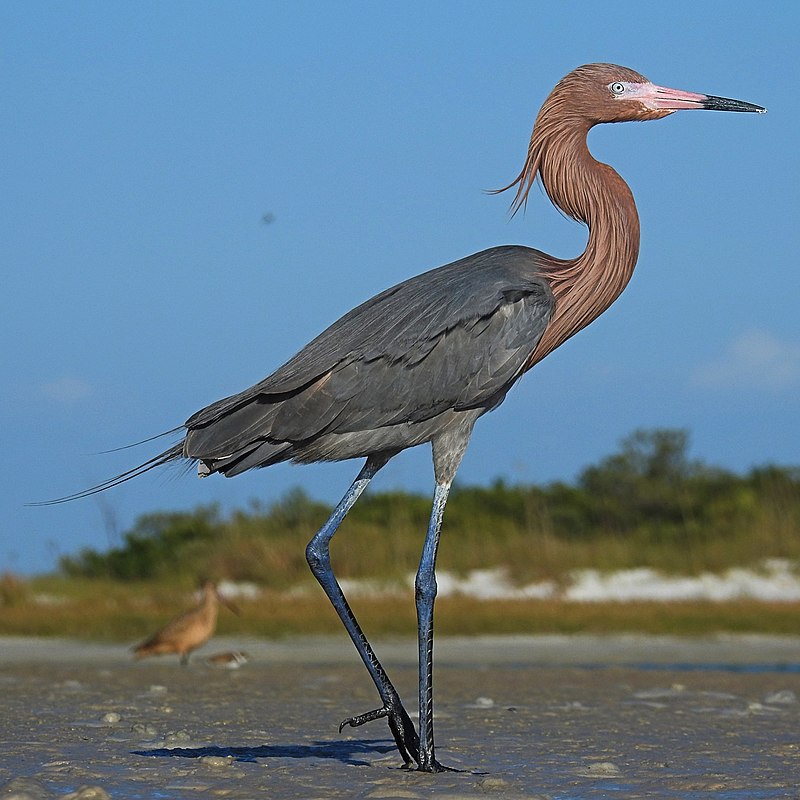
The Reddish Egret is a medium-sized heron that breeds in Central America, The Bahamas, the Caribbean, Texas and Mexico.
It prefers mud flats as its habitat due to its unique foraging behaviour, which differs from other herons.
In the past, it was hunted widely for its feathers used to make fashionable hats, but thankfully, this practice has now been stopped.
They have white or grey plumage with pink legs, and Bill gives them their name.
These birds feed mainly on fish, which they catch by quickly darting in shallow water or running rapidly through shallows, stirring up prey to snatch them easily with their bills.
Their long wings enable them to fly quickly when hunting and also during migration season when many travels southwards towards warmer climates.
Scientific classification:
| Kingdom | Animalia |
| Phylum | Chordata |
| Class | Aves |
| Order | Pelecaniformes |
| Family | Ardeidae |
| Genus | Egretta |
| Species | E. rufescens |
Also Featured In: Birds that Live around Southwest Florida, Birds You’ll Find in the Rio Grande Valley
7. Little Blue Heron
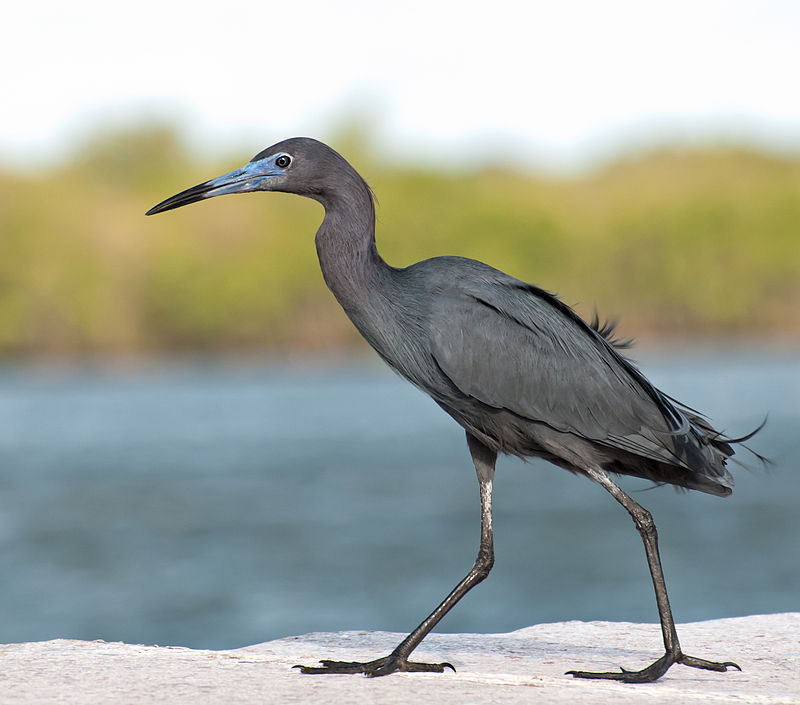
The Little Blue Heron is a small, darkly-colored heron with two-toned bill. Juveniles are completely white, similar to the Snowy Egret. In breeding season, adults develop unique colouration on their heads and legs.
The bird has an expansive habitat range that covers much of the Americas, from North America all the way down to South America.
They feed mostly in shallow water areas like tidal flats or marshes and eat small aquatic animals such as fish, frogs and crustaceans.
This species can also be found along coastal regions where they gather at night for roosting purposes during winter months when food sources become more scarce due to the migration patterns of its prey animals.
These birds have adapted well over time, allowing them to persist in most habitats throughout their wide range, even despite environmental changes caused by human activities such as pollution or development projects near wetlands ecosystems, which are essential for this species’ survival.
Scientific classification:
| Kingdom | Animalia |
| Phylum | Chordata |
| Class | Aves |
| Order | Pelecaniformes |
| Family | Ardeidae |
| Genus | Egretta |
| Species | E. caerulea |
Also Featured In: Wetlands Birds You Should Know, Puerto Vallarta Birds You Should Know
8. Cattle Egret
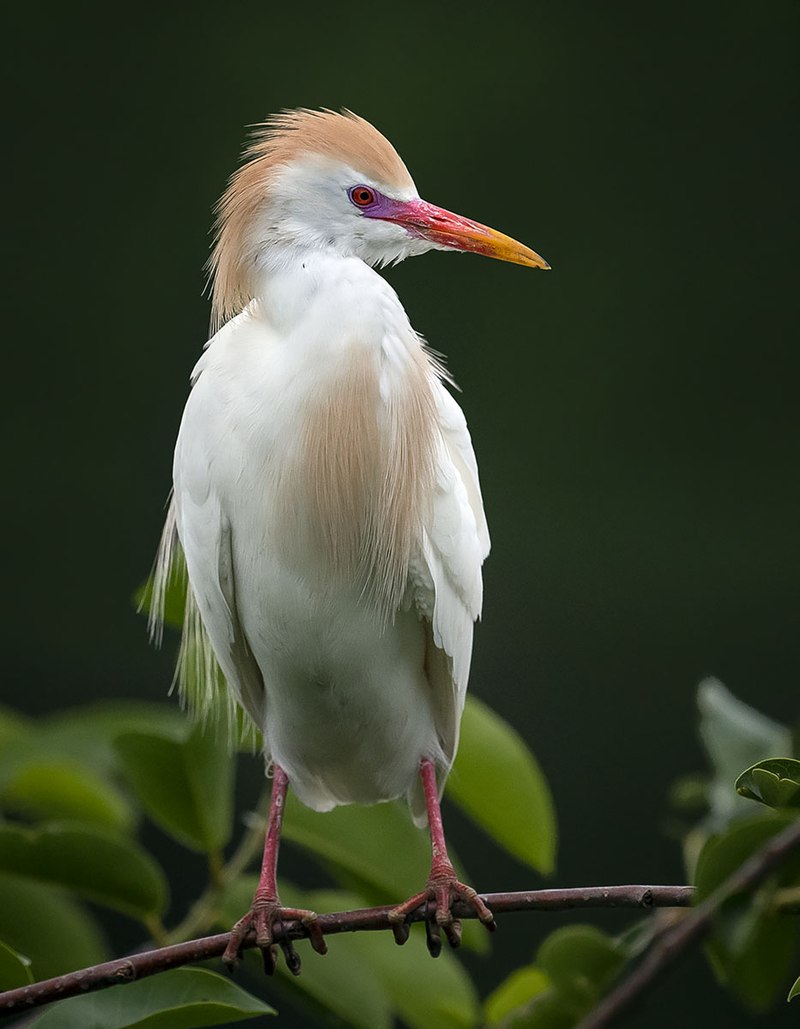
The Cattle Egret is a heron of the family Ardeidae found worldwide in tropical, subtropical and warm temperate areas. It has two subspecies: western cattle egret and eastern cattle egret.
They have white plumage with buff plumes on their head, neck and back. The beak is yellowish-orange with a black tip, while the legs are orange or yellow coloured depending on species variation.
This bird usually feeds near large herds of animals, such as cows, horses, etc., where it finds plenty of insects to eat, like grasshoppers, crickets, etc.
Its presence benefits these animals by removing ectoparasites from them, which leads to a healthier livestock population.
It nests colonially in trees or shrubs located close to water bodies during the breeding season, generally occurring between March and June every year.
Scientific classification:
| Kingdom | Animalia |
| Phylum | Chordata |
| Class | Aves |
| Order | Pelecaniformes |
| Family | Ardeidae |
| Genus | Bubulcus Bonaparte, 1855 |
| Species | B. ibis |
Also Featured In: Egyptian Birds, Asian Birds
9. Great Egret
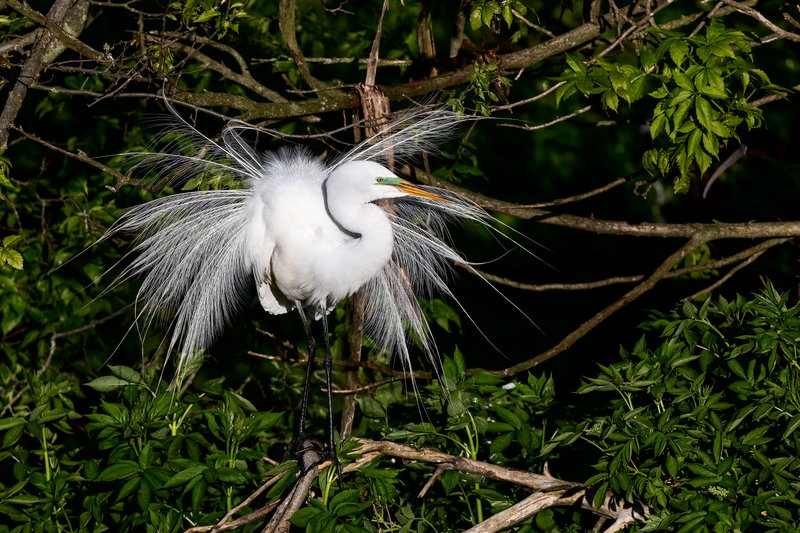
The Great Egret is a large, white bird found in many regions of the world. It has four subspecies that reside across Asia, Africa, the Americas and southern Europe.
This species usually lives near bodies of water such as lakes and marshes. They are also now starting to spread into more northern areas of Europe due to climate change.
These birds have long yellow legs with an impressive wingspan, allowing them to soar majestically through the sky, hunting for fish or amphibians in shallow waters below.
Their feathers have been used historically by Native Americans as part of traditional garments or ceremonies, but this practice should be avoided today so these amazing creatures can thrive without harm from humans.
Scientific classification:
| Kingdom | Animalia |
| Phylum | Chordata |
| Class | Aves |
| Order | Pelecaniformes |
| Family | Ardeidae |
| Genus | Ardea |
| Species | A. alba |
Also Featured In: Most common Birds in France, Most Common Romanian Birds
10. Glossy Ibis
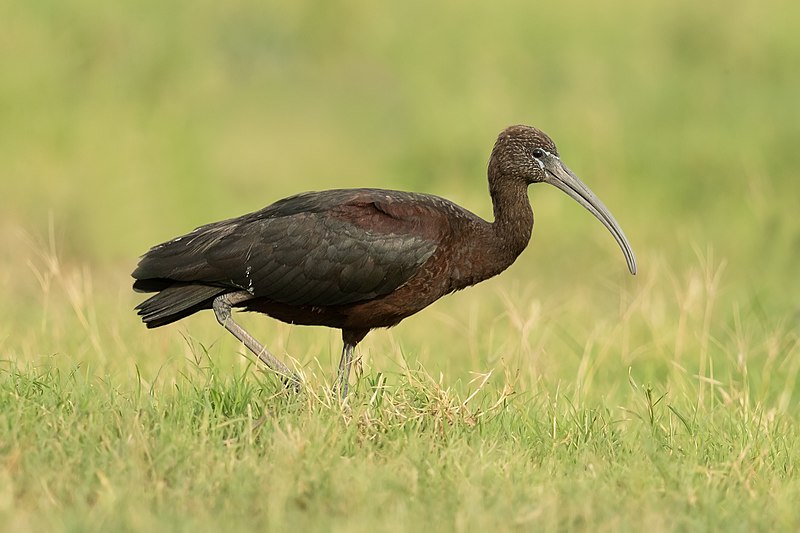
The Glossy Ibis is a water bird that belongs to the family Threskiornithidae. It has a unique bill in the shape of a sickle, which gave it its scientific name – Plegadis falcinellus.
It can be found widely across Europe, Asia and Africa, with scattered nesting sites in warm regions.
Its feathers are black-brown on top and chestnut brown from below; its wings have a glossy greenish-purple sheen when seen from afar.
They mainly feed on small insects like grasshoppers, spiders or earthworms, and crustaceans or amphibians caught while wading through shallow waters.
During the breeding season, they also consume plant material such as rice grains or corn kernels provided by humans near habitat areas where they nest.
Scientific classification:
| Kingdom | Animalia |
| Phylum | Chordata |
| Class | Aves |
| Order | Pelecaniformes |
| Family | Threskiornithidae |
| Genus | Plegadis |
| Species | P. falcinellus |
Also Featured In: Uganda Birds Species, Turkey Birds You Should Know
11. Fulvous Whistling Duck
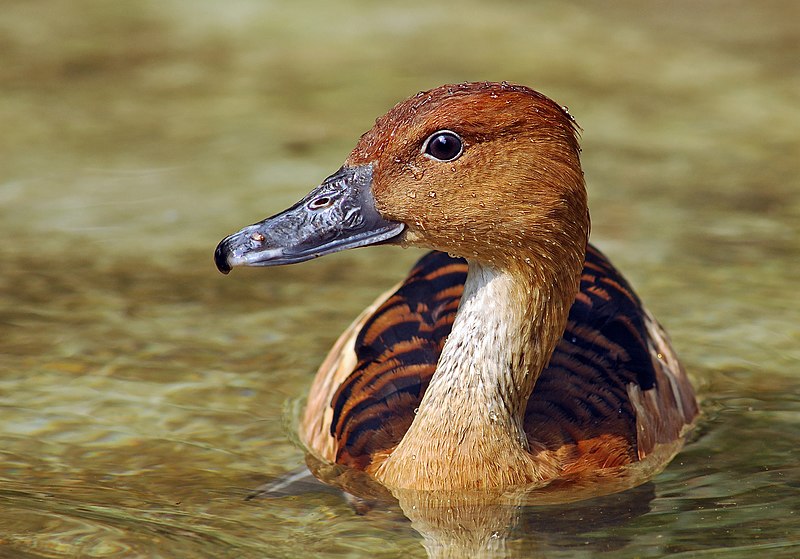
The Fulvous Whistling Duck is a species of whistling duck that can be found in tropical regions around the world.
It has reddish-brown plumage, long legs and a grey bill with a distinctive white band across it.
This bird usually lives near water sources like wetlands or marshes, where they feed on seeds, plants and small insects which make up their diet.
The male ducks are known to produce loud calls at night during breeding season as part of courtship rituals for attracting female partners.
They also congregate together in flocks when migrating from one area to another, making them visible even from far distances.
Overall, these amazing birds add beauty and joy to any natural environment.
Scientific classification:
| Kingdom | Animalia |
| Phylum | Chordata |
| Class | Aves |
| Order | Anseriformes |
| Family | Anatidae |
| Genus | Dendrocygna |
| Species | D. bicolor |
Also Featured In: Birds of Argentina, Caribbean Birds
12. Great Blue Heron
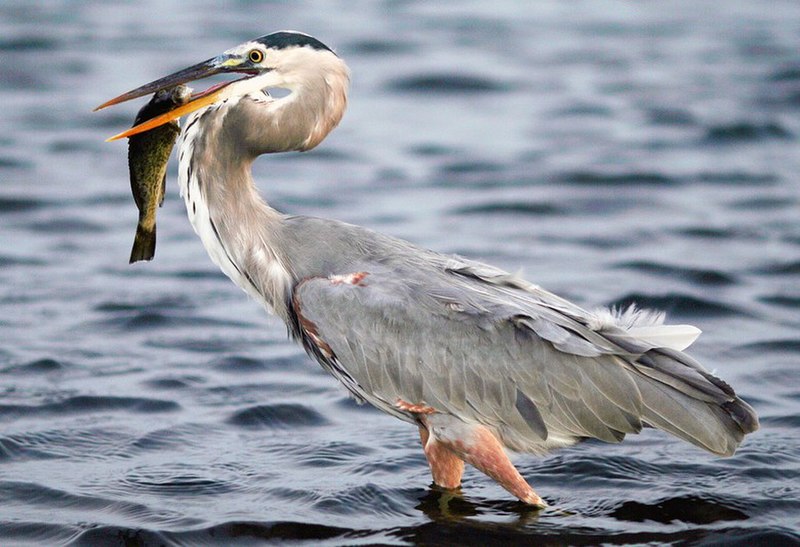
The Great Blue Heron is a majestic wading bird found in many parts of North America, Central America, the Caribbean and even as far away as the Galapagos Islands.
It has an impressive wingspan which can reach up to six feet wide. Its feathers are mainly bluish-grey with brownish streaks on both its neck and chest, while its head displays white plumes.
The adult herons can also be identified by their yellow bill and legs.
They live near bodies of water such as lakes, marshes or rivers, feeding on fish using a spear-like motion with their sharp bills.
An all-white population exists only in south Florida and the Florida Keys making it quite unique.
Scientific classification:
| Kingdom | Animalia |
| Phylum | Chordata |
| Class | Aves |
| Order | Pelecaniformes |
| Family | Ardeidae |
| Genus | Ardea |
| Species | A. herodias |
Also Featured In: Common Birds in Canada, Birds Commonly Found in New York
13. Piping Plover
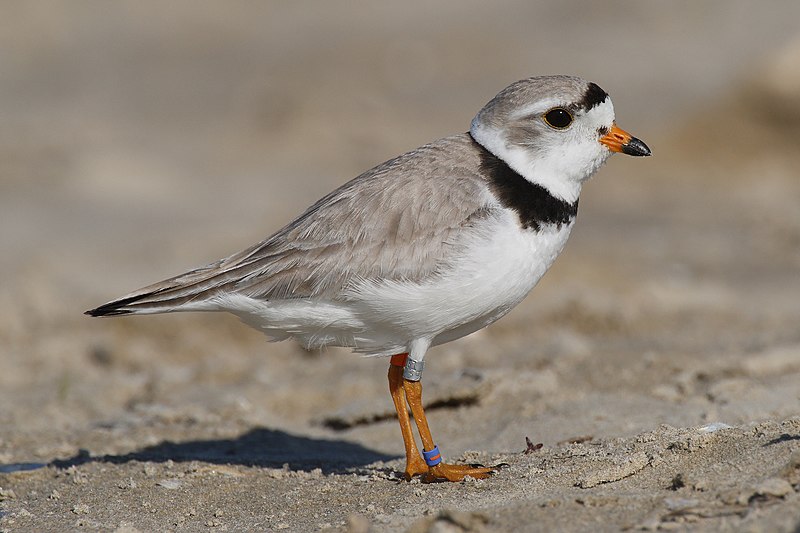
The Piping Plover is a small shorebird that can be found along sandy or gravel beaches in North America.
It has yellow-orange-red legs, and its distinctive features include a black band across the forehead from eye to eye and a thicker chest band for males during the breeding season.
They are threatened by human activity in their habitats, such as the increasing development of coastal areas and the destruction of their nesting sites due to recreation activities like beach driving and off-leash dogs.
Conservation efforts aim to protect these birds through habitat protection measures, including fencing off areas where they nest and restricting access during breeding seasons.
The future looks brighter with conservation initiatives by local governments slowly bringing the population up again over time.
Scientific classification:
| Kingdom | Animalia |
| Phylum | Chordata |
| Class | Aves |
| Order | Charadriiformes |
| Family | Charadriidae |
| Genus | Charadrius |
| Species | C. melodus |
Also Featured In: Long Island Birds You Should Know, Summer Birds that Live around Us
14. Black-Crowned Night Heron
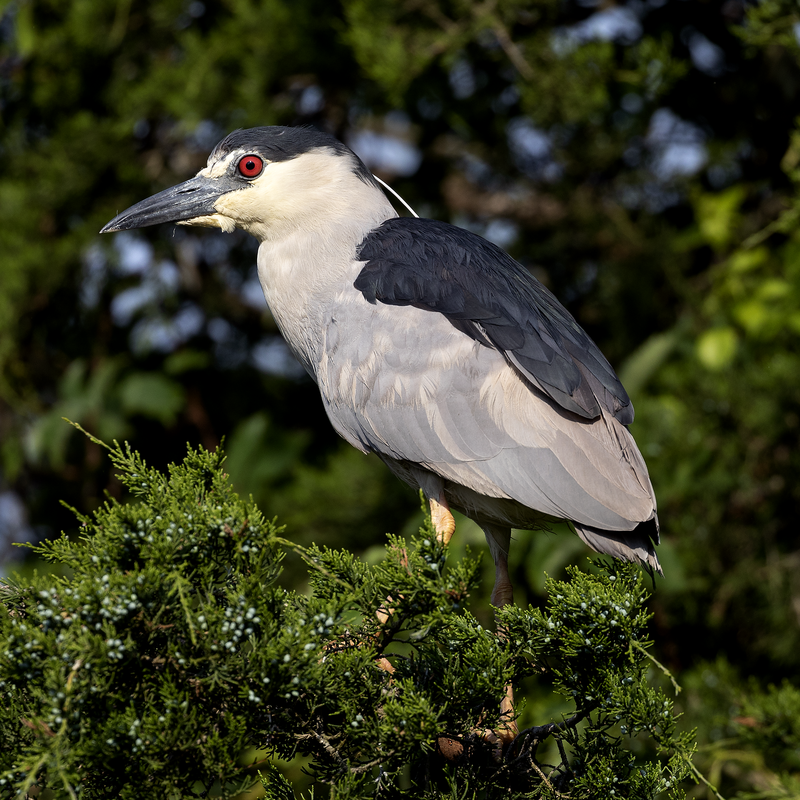
The Black-crowned night heron (Nycticorax nycticorax) is a medium-sized bird found in various parts of the world, including Europe, Asia and North and South America.
It has black crowns on its head with white feathers underneath. Its wings are greyish brown, while its underparts are mostly white.
This species can be seen foraging near shallow water or along coastlines during dusk or dawn as it hunts small fish, amphibians and crustaceans.
They also feed on insects such as grasshoppers and beetles, which they find in meadows close to freshwater bodies like lakes or ponds, where they breed during springtime, making nests using twigs lined with reeds and leaves near these waterside habitats.
In Australasia, this species hybridizes with the nankeen night heron that inhabits those areas instead; however, both populations remain distinct from each other despite their overlapping range regions.
Scientific classification:
| Kingdom | Animalia |
| Phylum | Chordata |
| Class | Aves |
| Order | Pelecaniformes |
| Family | Ardeidae |
| Genus | Nycticorax |
| Species | N. nycticorax |
Also Featured In: Common Birds Found in Switzerland, Birds of Kauai, Hawaii
15. Black-Bellied Whistling Duck
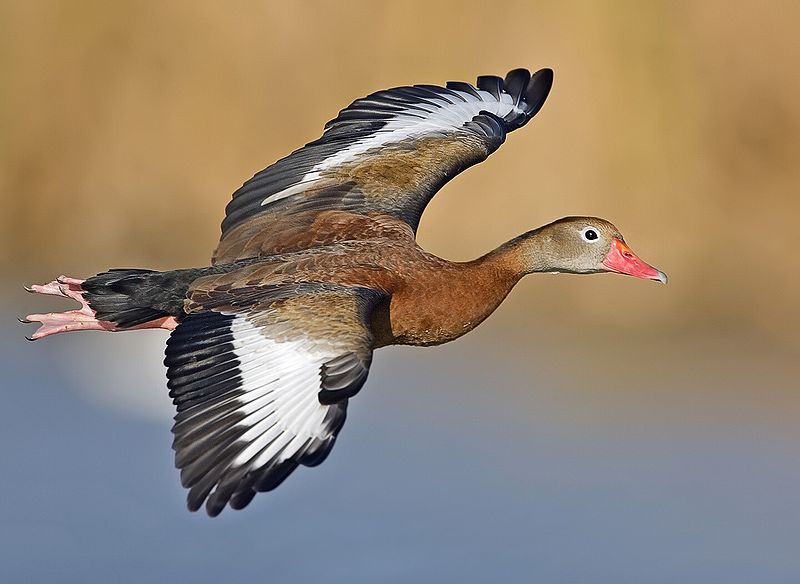
The Black-bellied whistling duck is a unique bird species found in the southern United States, Mexico, Central and South America. This small waterfowl has black plumage on its belly, giving it its name.
Its call is also distinctive as it makes high-pitched whistles to communicate with other members of its flock.
It prefers wetland habitats such as marshes, ponds and lakes, where they feed on seeds and aquatic plants like wild rice or pondweed.
During breeding season, these birds form monogamous pairs and nest in trees near bodies of water.
They are migratory birds, but some may remain year-round depending upon local climate conditions, making them relatively common sights in certain areas during winter months when most other ducks have migrated further south for warmer weather.
Scientific classification:
| Kingdom | Animalia |
| Phylum | Chordata |
| Class | Aves |
| Order | Anseriformes |
| Family | Anatidae |
| Genus | Dendrocygna |
| Species | D. autumnalis |
Also Featured In: El Salvador Birds, Common San Antonio Birds
16. Roseate Spoonbill
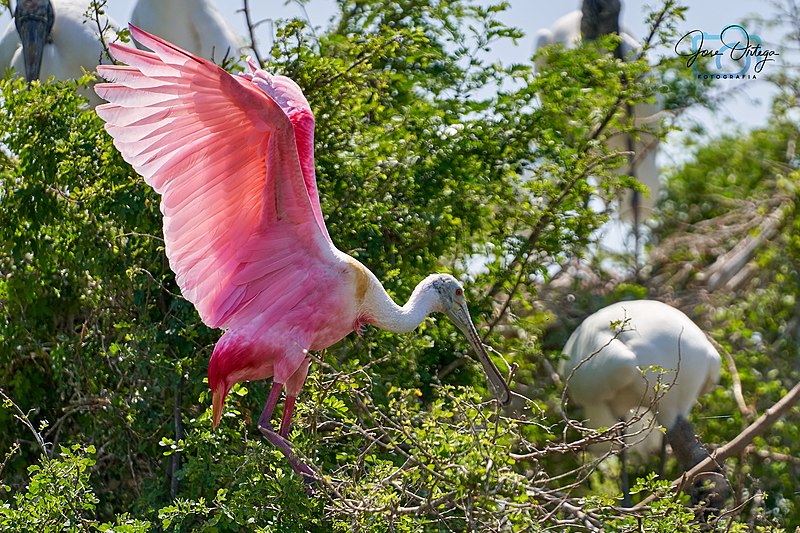
The Roseate Spoonbill is a beautiful and majestic bird in North and South America.
It belongs to the ibis family, Threskiornithidae, and its vibrant pink colour comes from canthaxanthin pigment derived from their diet of crustaceans like shrimp.
Sadly, plume hunting almost drove this species close to extinction during the 18th and 19th centuries, but fortunately, it’s coming back due to conservation efforts made by dedicated wildlife organisations.
Its large spoon-like bill helps them filter out food sources such as small fish or frogs from shallow water areas while they wade through mudflats with their long legs looking for something tasty.
With its unique appearance, graceful wingspan, and impressive flight capabilities, the Roseate Spoonbill is an incredibly photogenic animal that will captivate the attention of any viewer lucky enough to witness it in all its glory.
Scientific classification:
| Kingdom | Animalia |
| Phylum | Chordata |
| Class | Aves |
| Order | Pelecaniformes |
| Family | Threskiornithidae |
| Genus | Platalea |
| Species | P. ajaja |
Also Featured In: Costa Rica Birds, Famous Paintings Birds
17. Wood Stork
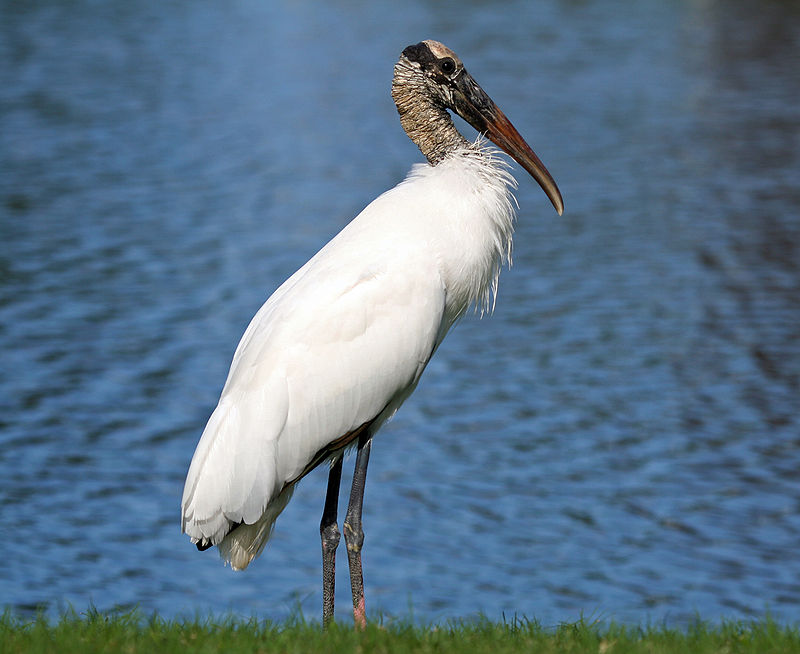
The Wood Stork is a large wading bird found in subtropical and tropical habitats throughout the Americas, including the Caribbean. Its distinctive white head and neck feathers stand out from other storks.
The wood stork has an impressive wingspan of up to 6 feet wide, making it one of the largest birds in North America.
Although usually seen near water sources such as swamps or wetlands looking for food like fish, crabs, frogs and even small reptiles, they can sometimes be spotted far away from their natural habitat during migration season.
This species is also one of few that breeds annually in North America, with nests typically built on platforms made by humans or animals near water bodies or ponds.
Scientific classification:
| Kingdom | Animalia |
| Phylum | Chordata |
| Class | Aves |
| Order | Ciconiiformes |
| Family | Ciconiidae |
| Genus | Mycteria |
| Species | M. americana |
Also Featured In: Georgia Birds, Autumn Birds You Should Know
18. Spotted Sandpiper
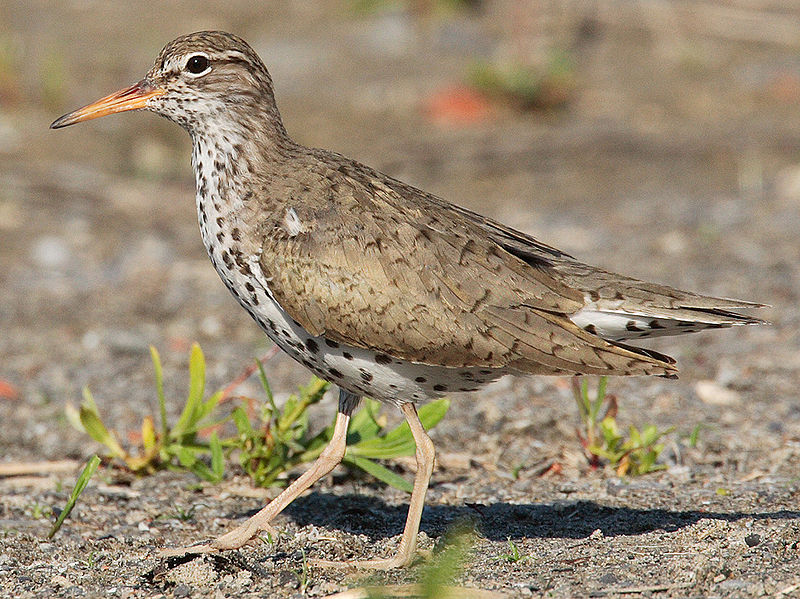
The Spotted sandpiper (Actitis macularius) is a small shorebird that can be found across North America and parts of South America.
It has an appealing spotted plumage, predominately brown in colour, with white spots on the wings, tail feathers, head and neck.
The Common Sandpiper (A. hypoleucos) is its sister species, which takes over geographically when the other moves away; they have been known to hybridize as well when strays settle down among breeders.
This bird was first described by Carl Linnaeus in 1766 in his twelfth edition of Systema Naturae as a migratory summer visitor to Europe, but it now also occupies many habitats like beaches, riversides and even grasslands during migration periods or for the breeding season itself.
Its diet consists mainly of insects such as air-borne flies and molluscs from shallow water areas, making them quite unique amongst waders.
Scientific classification:
| Kingdom | Animalia |
| Phylum | Chordata |
| Class | Aves |
| Order | Charadriiformes |
| Family | Scolopacidae |
| Genus | Actitis |
| Species | A. macularius |
Also Featured In: Suriname birds, Birds in Calgary You’ll Love to See
19. Yellow-Crowned Night Heron
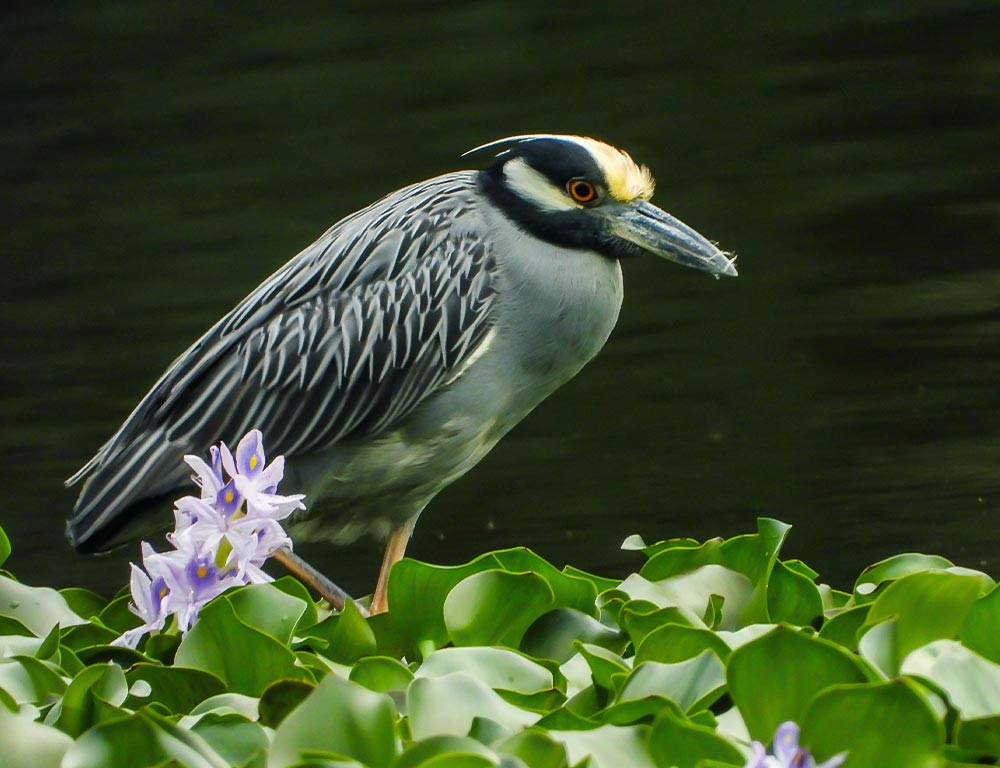
The Yellow-crowned night heron is a beautiful and unique bird species native to the Americas. It has distinctive yellow crowns on its head, making it easy to identify among other herons.
These birds are also larger than most other types of herons, reaching up to 70 cm in length and 850 g in weight.
They usually feed on small fish or crustaceans while wading through shallow waters with their long legs.
The yellow-crowned night heron can be found near marshes or lakes during the breeding season when they build nests made from twigs high above the ground for protection against predators like raccoons and foxes.
This majestic bird is an important part of wetland ecosystems as it helps balance populations of smaller aquatic animals by preying upon them.
Scientific classification:
| Kingdom | Animalia |
| Phylum | Chordata |
| Class | Aves |
| Order | Pelecaniformes |
| Family | Ardeidae |
| Genus | Nyctanassa |
| Species | N. violacea |
Also Featured In: Bermuda birds, Flight Birds You Should Know
20. American Bittern
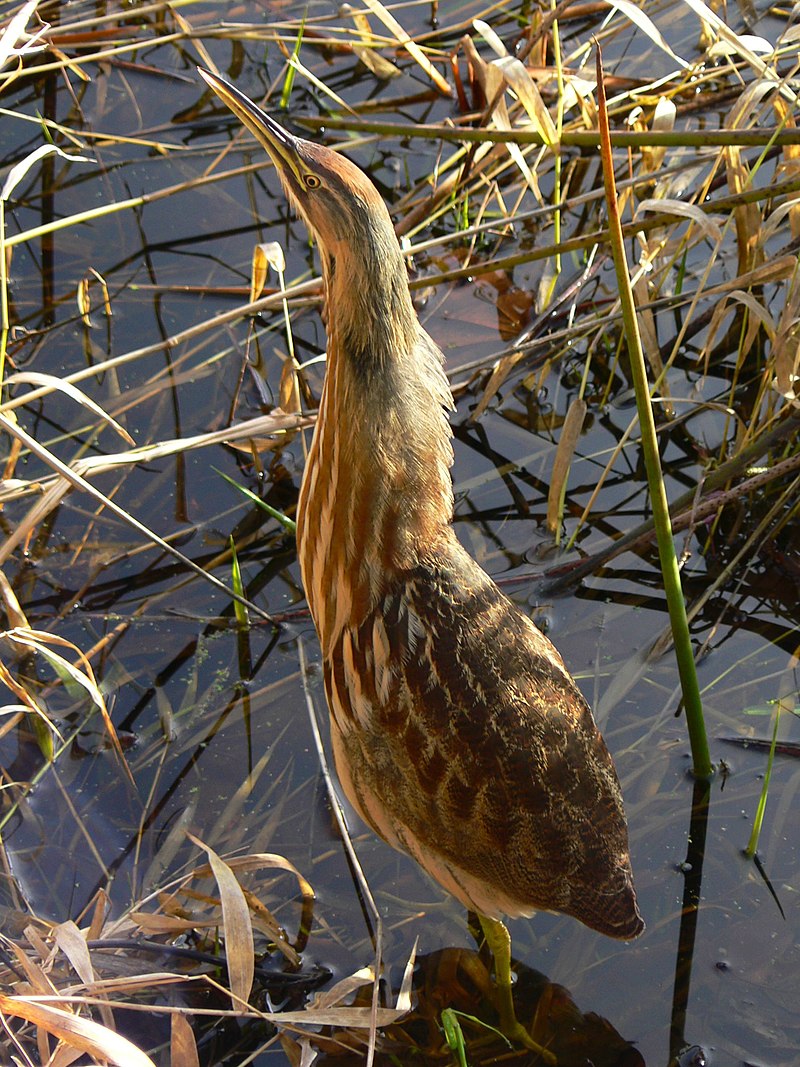
The American Bittern is a solitary, brown-wading bird from the heron family. It lives in North America and Central America, breeding in Canada and northern parts of the United States before migrating south to winter on the states surrounding the Gulf Coast and Florida’s Everglades.
Not only does it blend into its surroundings thanks to its muted colouring, but it also has a unique call that helps keep it hidden – an “un-ducklike” booming sound that can travel long distances due to low-frequency vibrations.
The bittern spends most of their time alone, but during mating season, they become more social while gathering together at wetlands for courtship activities such as displaying feathers erect or head bobbing.
Scientific classification:
| Kingdom | Animalia |
| Phylum | Chordata |
| Class | Aves |
| Order | Pelecaniformes |
| Family | Ardeidae |
| Genus | Botaurus |
| Species | B. lentiginosus |
Also Featured In: Herons Species, Birds That Live in Colorado
21. Double-Crested Cormorant
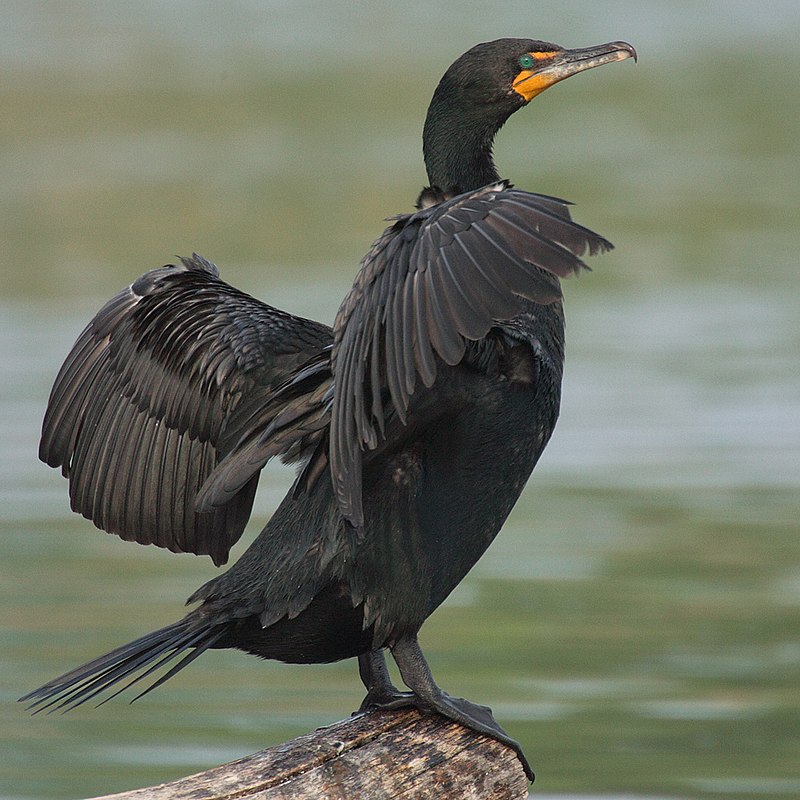
The double-crested cormorant is a majestic bird with an impressive wingspan, found across North America from the Aleutian Islands all the way down to Mexico.
Its black plumage stands out against its bright orange-yellow facial skin and some extended patches of white feathers on each side of its throat.
It measures 28 – 35 inches in length and has webbed feet that enable it to swim gracefully through rivers, lakes, and coastal areas.
These birds are known for their voracious appetite for fish, sometimes diving over 100 ft deep into water looking for food.
Despite this reputation, they also feed on crustaceans, amphibians, and insects when they are available.
Cormorants have been part of many cultures throughout history due to their remarkable ability to fly long distances, making them valued messengers or companions during fishing expeditions at sea.
Scientific classification:
| Kingdom | Animalia |
| Phylum | Chordata |
| Class | Aves |
| Order | Suliformes |
| Family | Phalacrocoracidae |
| Genus | Nannopterum |
| Species | N. auritum |
Also Featured In: Cormorant Species, Water Birds Live around Us
22. American Purple Gallinule
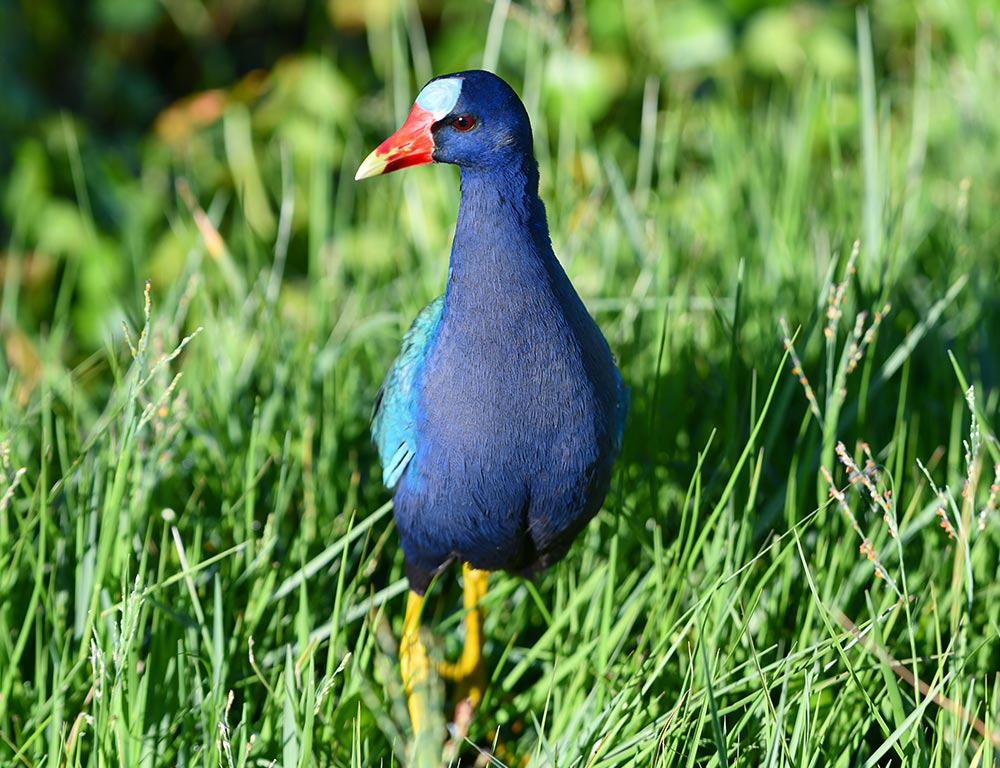
The American purple gallinule is a stunning bird found in North and South America. This species belongs to the order Gruiformes, which contains cranes, rails and crakes.
The family Rallidae classifies it as a rare species, with its scientific name being Porphyrio martinica.
It is also known locally as the yellow-legged gallinule due to its striking plumage of greenish-blue feathers on its wings, back and tail, and bright red legs and bill.
Its environment includes freshwater marshes, swamps or paddy fields where these birds feed mostly on plants like water lilies or small invertebrates such as insects or molluscs.
These beautiful creatures are threatened by habitat destruction, especially for agricultural purposes, but conservation efforts are helping them survive despite this threat.
Scientific classification:
| Kingdom | Animalia |
| Phylum | Chordata |
| Class | Aves |
| Order | Gruiformes |
| Family | Rallidae |
| Genus | Porphyrio |
| Species | P. martinicus |
Also Featured In: Florida Birds, Blue Birds You’ll Found around Us
23. Anhinga
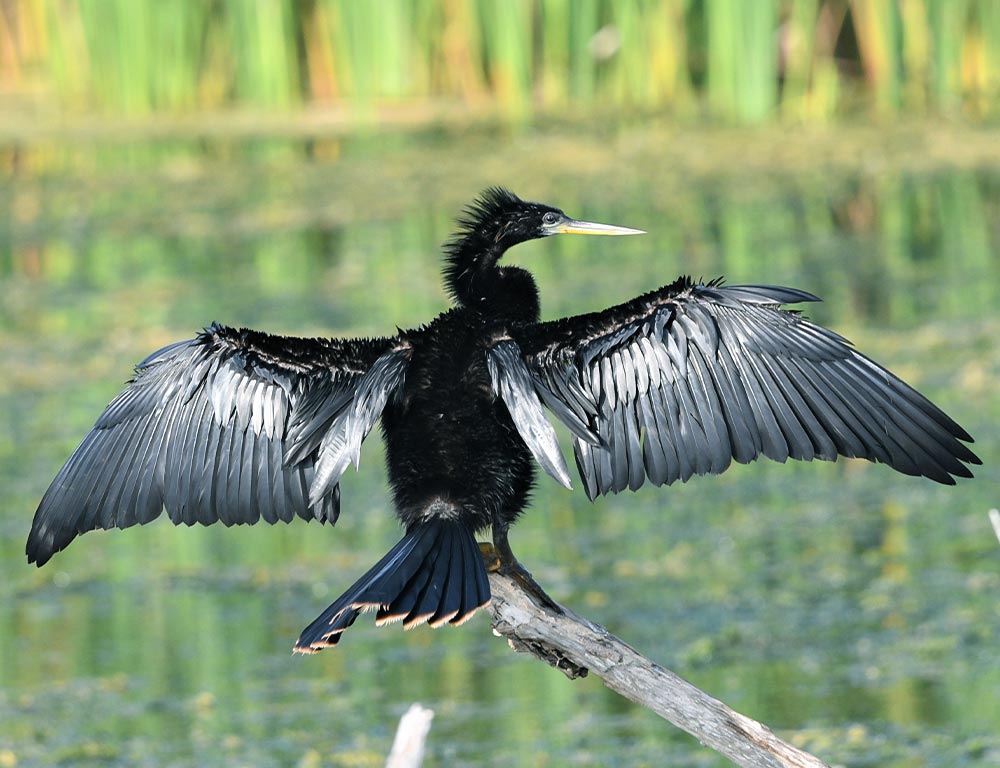
The Anhinga is a water bird found in the warmer parts of the Americas. It is sometimes called the snakebird, American darter, or water turkey.
The bird’s name comes from the Brazilian Tupi language and means “devil bird” or “snake bird.” When swimming, only the Anhinga’s neck appears above water, giving the appearance of a ready-to-strike snake.
It is a skilled swimmer and hunter, using its sharp beak to catch fish underwater. The Anhinga is easily recognizable by its long neck, sharp beak, and distinctive black and white feather colouring.
Its ability to dry its wings quickly after diving is unique among water birds, as it lacks the natural oils that make feathers waterproof.
The Anhinga is an important ecosystem member, helping control fish populations and serving as prey for larger predators.
Scientific classification:
| Kingdom | Animalia |
| Phylum | Chordata |
| Class | Aves |
| Order | Suliformes |
| Family | Anhingidae |
| Genus | Anhinga |
| Species | A. anhinga |
Also Featured In: Everglades Birds, Birds that Live around Central Florida
24. Least Sandpiper
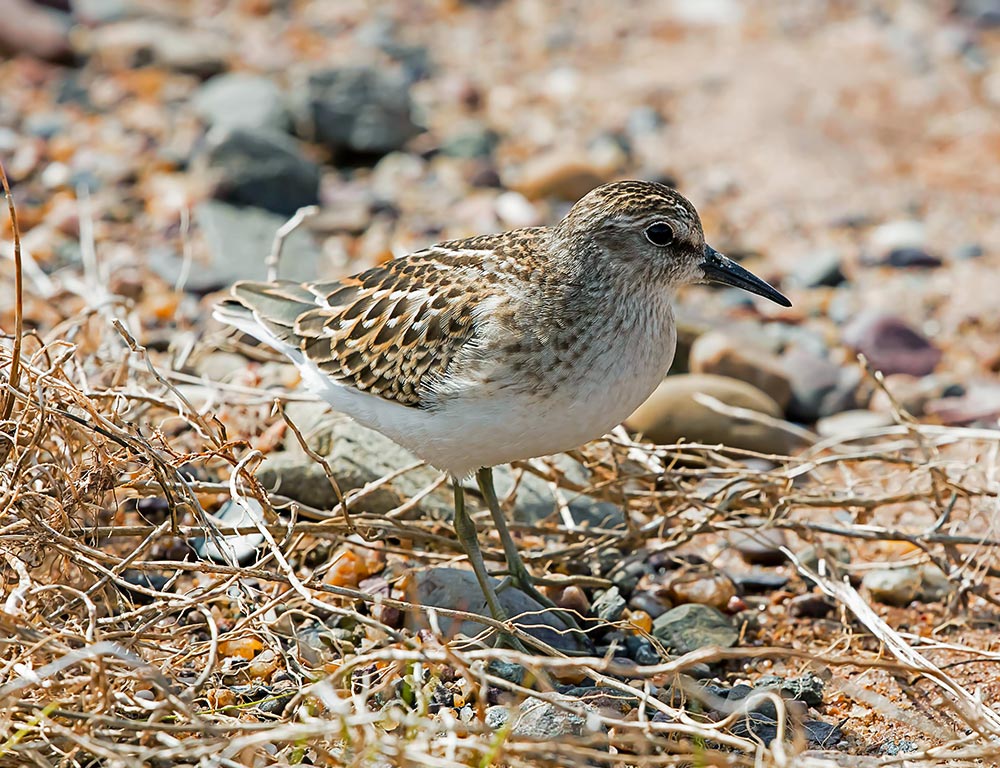
The Least Sandpiper is a shorebird that holds the title for being the smallest of its kind. Its Ancient Greek genus name, kalidris or skalidris, referred to grey-coloured waterside birds.
The breed’s brown feathers with dark brown streaks, white underside, greenish legs, and short, thin, dark bill characterize adult Least Sandpipers.
The Medieval Latin name of the species, minutilla, further describes the breed’s tiny size.
These birds are known to inhabit shallow water marshes and mudflats during the summertime, and they migrate to coasts during the winter.
Least Sandpipers mainly feed on insects and small crustaceans, often by running and pecking in shallow water or mud.
Despite their small size, these birds travel great distances during migration, making impressive journeys from their breeding and wintering grounds.
Scientific classification:
| Kingdom | Animalia |
| Phylum | Chordata |
| Class | Aves |
| Order | Charadriiformes |
| Family | Scolopacidae |
| Genus | Calidris |
| Species | C. minutilla |
Also Featured In: Most Common Lake Birds, Birds in Pacific Northwest